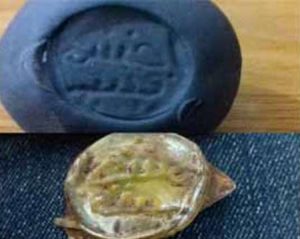Archaeological investigation in the village of Natel Kenar Olia, by the city of Nour, northern Iran, resulted in numerous finds, among which are different architectural remains, including establishment of a castle, pottery dated to of the 3rd-4th centuries, and a glass seal with inscriptions in Kufic.

Kufic is the oldest calligraphic form of the various Arabic scripts and consists of a modified form of the old Nabataean script. The glass seal dates to the 4th century AD. The castle is dated to the Safavid era (1501–1736 AD). It consists of a a central building and a bath. Remains of walls of the a castle have ditches dug for defensive purposes. The main construction materials used are large and medium-sized pebbled river stones, used both in the flooring and for the walls. The central building is rectangular with a wall in the form of porch. Other parts of the castle consist of such features as a water reservoir, and a hexagonal shaped pond with brick walls and floor and a water storage built with pebbled river stones. Archaeologists also discovered remains of a furnace which might have been used for glass production, as indicated by distorted remains of glass vessels found inside it.
(after Islamic Republic News Agency)